Giganotosaurus is the latest dinosaur villain in the Jurassic World Dominion. Like many dinosaurs, Giganotosaurus was a ferocious and gigantic beast. Due to similarities in appearance and size, this large dinosaur is often compared to the Tyrannosaurus Rex, known as the “King of the Tyrant Lizards.” Giganotosaurus is one of the few dinosaurs that would give the T-Rex a hard time in a fight. Just how big was Giganotosaurus? Was It a T-rex killer? Find out in this article.
Meet Giganotosaurus Carolinii

Giganotosaurus carolinii roamed the Earth about 99.6 to 97 million years ago.
©Jonathan Chen / CC BY-SA 4.0 – License
Giganotosaurus carolinii roamed the Earth about 99.6 to 97 million years ago in the Late Cretaceous period. Giganotosaurus, translated to “Giant Southern Lizard,” belonged to the Carcharodontosauridae family, known as shark-toothed lizards, as the only species of its genus.
The only other genus that belongs to the Giganotosaurini tribe is Mapusaurus. They share similar femur features, but Mapusaurus is smaller than its close cousin.
How Big Was Giganotosaurus?
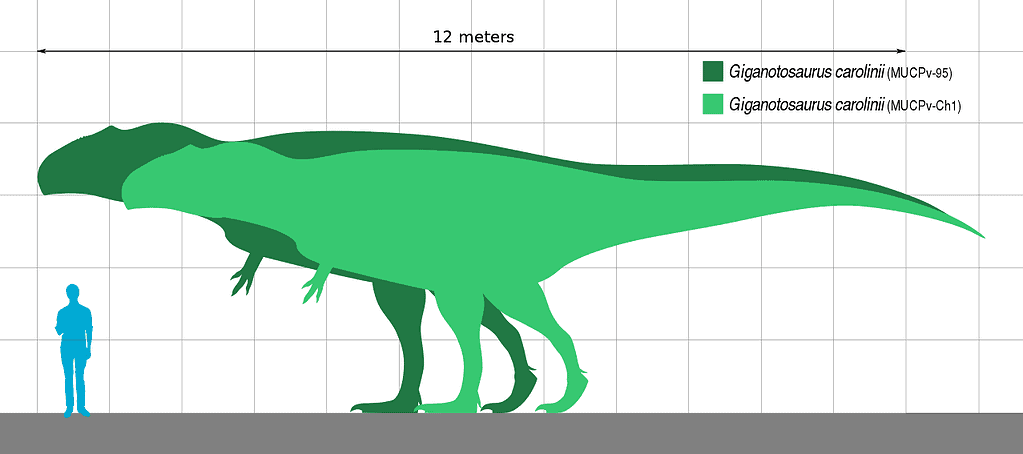
Giganotosaurus is believed to have measured between 40 to 43 feet long and weighed up to 14 tons.
©KoprX / CC0 1.0 – License
According to reports, Giganotosaurus measured between 40 to 43 feet in length and weighed nearly 14 tons. From the top of its head to its toes, the dinosaur measured up to 23 feet, making it one of the largest land carnivores ever, larger than the T-Rex. However, due to the incomplete discovery of the dinosaur’s fossils, there have been debates about its size, with some arguing that it was not bigger than the T-Rex but roughly equal in size.
At the time of discovery, Giganotosaurus was believed to be the largest theropod before the discovery of another carnivorous dinosaur species about two years later. As far as carnivorous dinosaurs go, the semi-aquatic Spinosaurus is the longest. The dinosaur was found in North Africa in about the same period as Giganotosaurus. This theropod was estimated to grow over 46 feet in length.
How Did Giganotosaurus Look?
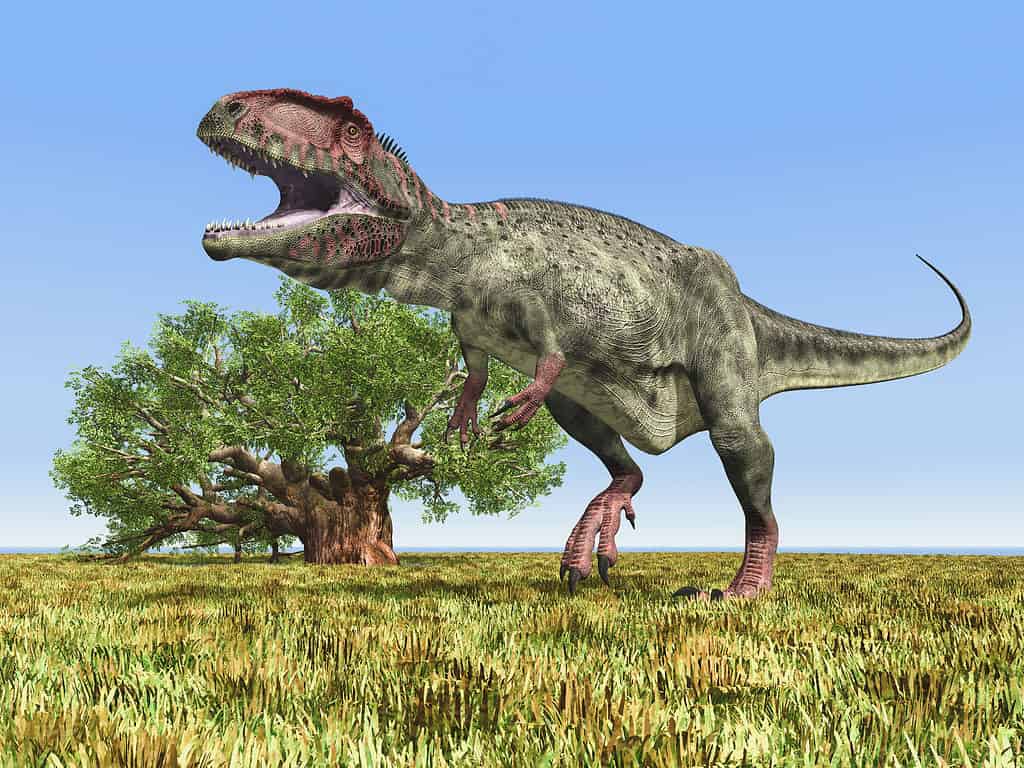
Giganotosaurus looked like a T-Rex but taller and slimmer.
©iStock.com/MR1805
According to the Natural History Museum, Giganotosaurus was taller and longer than the popular T-Rex. Its femur was barely two centimeters longer. However, it was slimmer, sparking a debate about the relative size of both animals.
Another distinctive feature of the Giganotosaurus was that it had three fingers, while T-Rex is known to have only two. Despite these differences, both dinosaurs walked on their two hind legs and had forelimbs that were extremely smaller in comparison.
Giganotosaurus had a skull larger than the average human, a robust neck, and a powerful thin pointed tail with which it balanced its weight when it ran. The large dinosaur had long, flat, and curved teeth.
Diet: What Did Giganotosaurus Eat?
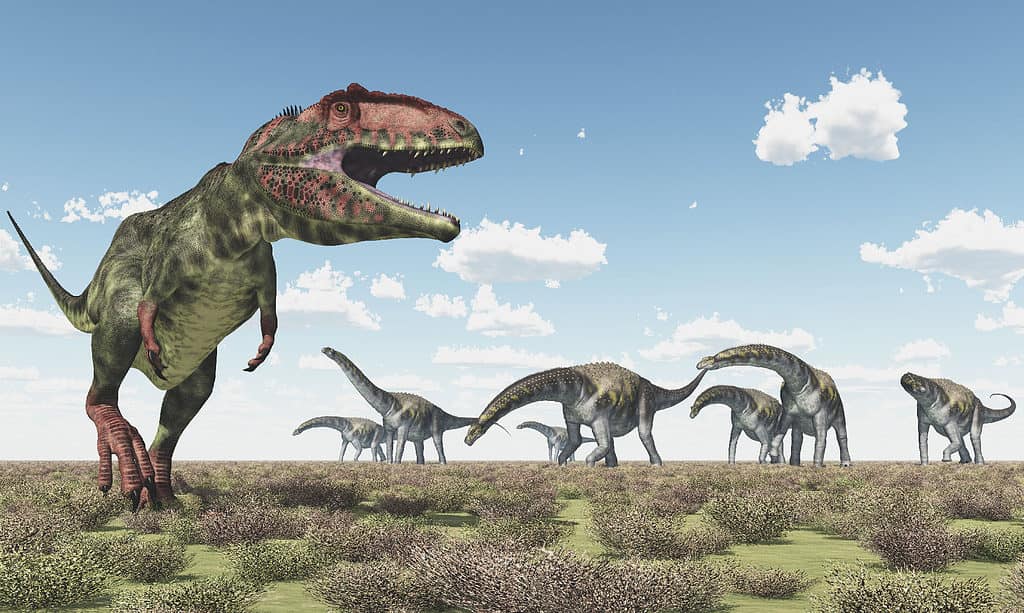
Giganotosaurus ate meat and hunted large herbivorous dinosaurs.
©Michael Rosskothen/Shutterstock.com
Giganotosaurus was one of the largest terrestrial carnivores ever and an apex predator. Given its enormous size and powerful large jaws, the large dinosaur could have fed on any available animal in its surrounding, including juvenile herbivorous dinosaurs such as sauropods.
Giganotosaurus was most likely an opportunistic predator that also scavenged sometimes. However, some scientists believed that these dinosaurs moved and hunted as a group and might have been able to bring down an adult sauropod or other large dinosaurs.
Giganotosaurus was warm-blooded and had a metabolism that was similar to those of mammals and reptiles. This is presumed to be one of the reasons for the size of this dinosaur.
Habitat: Where Did Giganotosaurus Live?
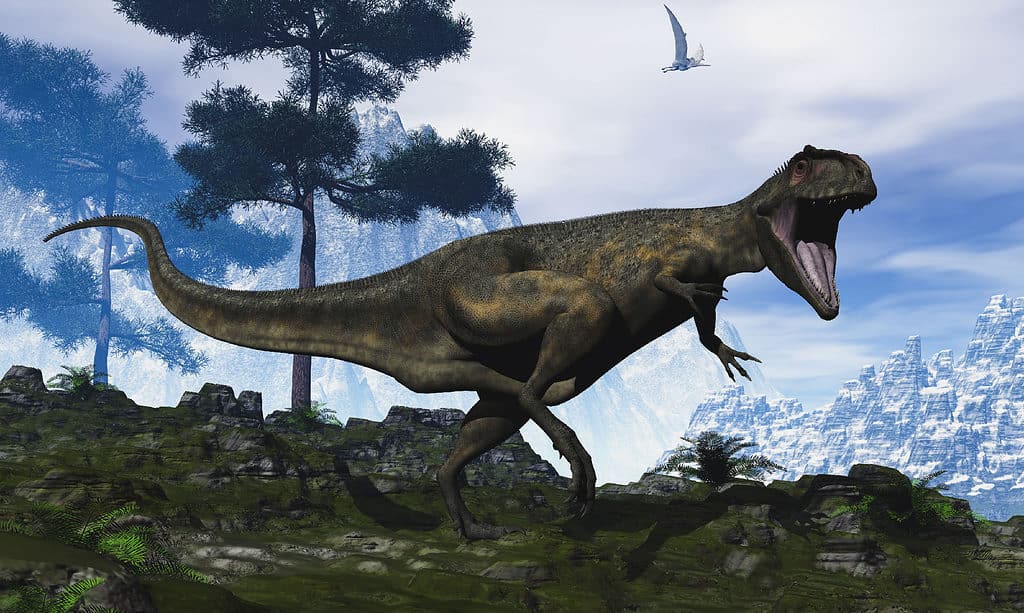
Scientists believe that Giganotosaurus lived in swamplands and savannahs in Argentina.
©iStock.com/Elenarts108
Giganotosaurus lived in the area now known as Argentina in South America. Based on the discovery of clay residue in the excavation sites of the large dinosaur, it is believed that they might have dwelled in swamplands and savannahs. Thicker forests would have been unconducive for these large animals.
Predators and Threat: What Animals Hunted Giganotosaurus?
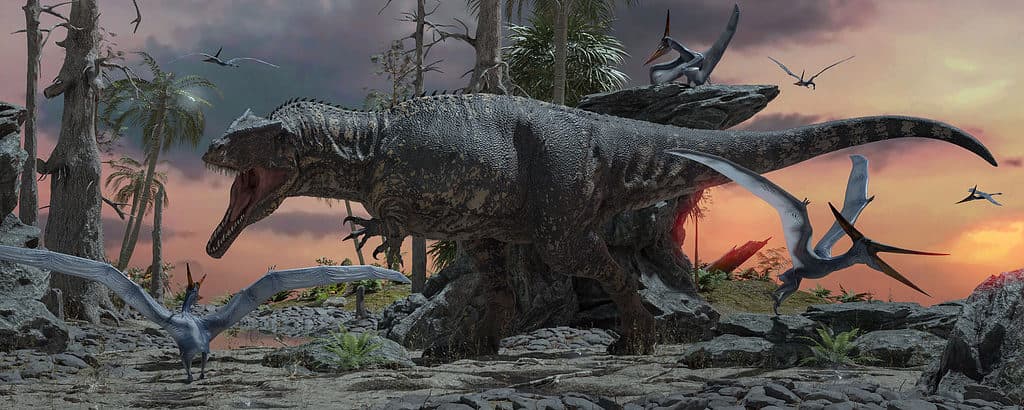
As apex predators, Giganotosaurus did not have any natural predator.
©Herschel Hoffmeyer/Shutterstock.com
Giganotosaurus was an apex predator that towered over most carnivorous dinosaurs in its time. However, juvenile Giganotosaurus would have been vulnerable to easy predation by other meat-eating dinosaurs.
Fossil and Discoveries: Where and When Giaganotosarus Was Discovered

The first fossil of Giganotosaurus was found in Argentina in 1993.
©William Cushman/Shutterstock.com
According to news reports, the first fossil of Giganotosaurus carolinii was found in the Patagonian area of Argentina in 1993. The discovery was made by a paleontologist enthusiast, Ruben Carolini, after whom the dinosaur was named. The fossil found was about 70% complete, and included parts of the skull, pelvis, leg bones, and backbone.
The discovery of the extinct dinosaur brought archeologists and tourists to the Villa El Chocon village, where it was found, giving the then-migrating villagers a reason to stay. The only other fossil of Giganotosaurus found was of lower jaw fragments in the same area. The dinosaur was officially named two years after its discovery by Researchers Leonardo Salgado and Rodolfo Coria.
Extinction: How Did Giganotosaurus Become Extinct?
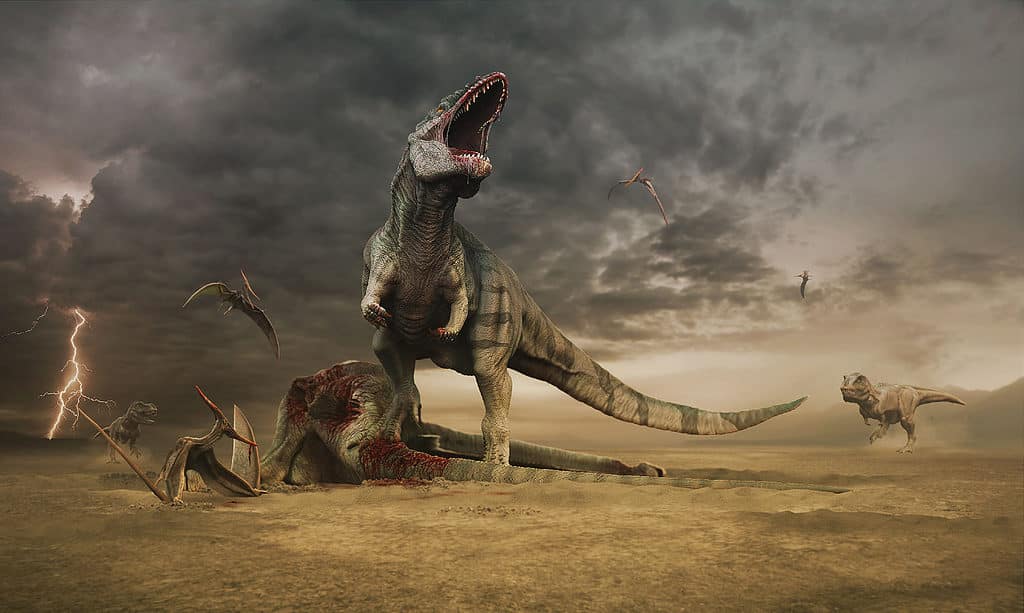
Giganotosaurus became extinct about 90 million years ago.
©Herschel Hoffmeyer/Shutterstock.com
Little is known about Giganotosaurus’ extinction, along with that of other Carcharodontosaurian dinosaurs, which occurred about 90 million years ago. The rarity of the fossils of these ancient reptiles also doesn’t help. However, the extinction of these dinosaurs coincides with the rise of Tyrannosaurids during that period.
Tyrannosaurus Rex would appear almost 30 million years later and live until the descent of the mountain-sized asteroid that wiped out all dinosaurs from the earth. This brought the end to the Cretaceous period.
Giganotosaurus Vs. T-Rex: Which is Deadlier?
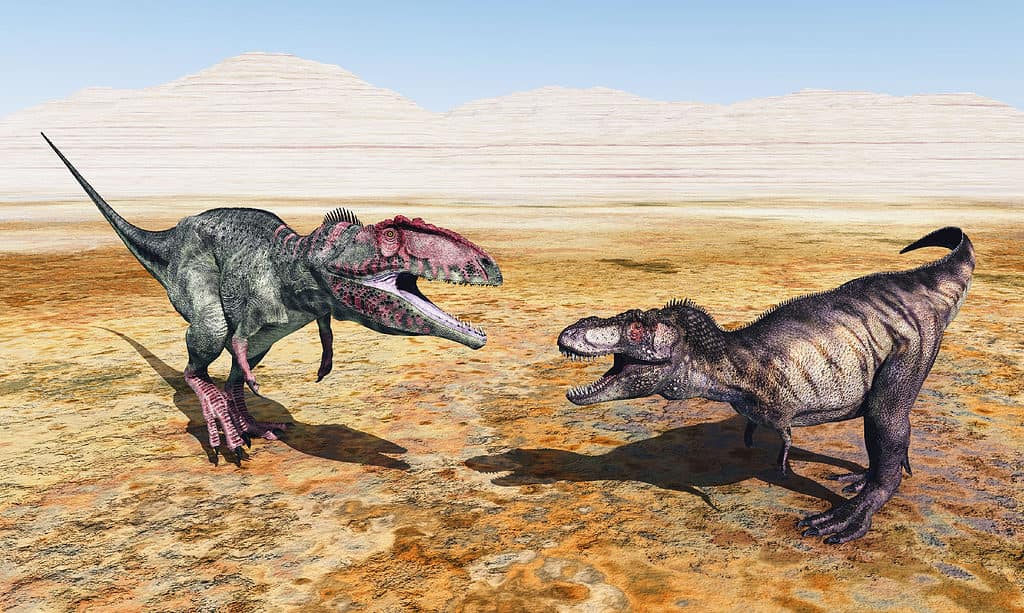
T-Rex is deadlier than Giganotosaurus.
©iStock.com/MR1805
Though Giganotosaurus lived almost 30 million years before Tyrannosaurus Rex, and both lived on different American continents, it is impossible to not imagine these giant carnivores fighting. What if they met and fought?
Based on their relative sizes and characteristics, Tyrannosaurus Rex is believed to be the most probable winner of the two dinosaurs. This is majorly due to their offensive capabilities. While Giganotosaurus was faster than the T-Rex, reaching 31 mph, it had a weaker bite force than its bone-crushing opponent. Each tooth of the T-Rex has been likened to “killer bananas,” and combined with the ramming tactic of the large dinosaur, the slimmer Giganotosaurus might lose.
Up Next:
Giganotosaurus vs T-Rex: Who Would Win in a Fight?
How Long Were Dinosaurs on Earth?
Was Spinosaurus Bigger Than Giganotosaurus?
Discover the 8 Smartest Dinosaurs Ever to Live – See Where T-Rex Ranks
Meet the Ground Sloth That Stood as Tall as a House and Weighed 4 Tons
The photo featured at the top of this post is © iStock.com/Elenarts108
Sources
- , Available here: https://www.nhm.ac.uk/discover/dino-directory/giganotosaurus.html
- Maria Victoria Ennis, Available here: https://english.elpais.com/science-tech/2022-06-10/the-gigantosaurus-what-was-the-new-jurassic-park-villain-like-in-real-life.html
- Joseph Castro, Available here: https://www.livescience.com/24642-giganotosaurus.html
- , Available here: https://royalsocietypublishing.org/doi/10.1098/rsos.210923
Thank you for reading! Have some feedback for us? Contact the AZ Animals editorial team.







